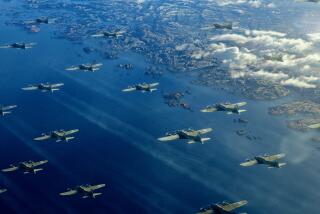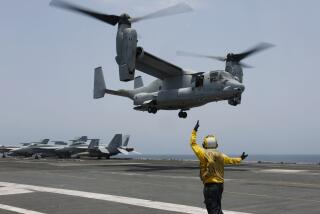Patched-Up Marine Wants to Fly Again
SAN DIEGO — Marine Col. Jerry Cadick’s F/A-18 was traveling about 350 knots, low across the El Toro airfield, when he pulled on the stick, and the plane shot from a horizontal to a vertical direction.
The veteran pilot began making a big loop, and the aircraft turned upside down just before it headed straight back toward the ground.
Noise from the two screaming jet engines brought a gasp from the 350,000 onlookers attending the April 24 Navy Relief Air Show at El Toro Marine Corps Air Station.
Even those who were new to air shows realized Cadick’s plane--descending at 10,000 feet a minute--was too low at the bottom of the loop.
The tail of the 56-foot-long F/A-18 Hornet hit the runway. Sparks and smoke spewed from the back of the plane, which momentarily struggled to regain lost altitude.
Then the nose of the $18-million aircraft slammed to the earth with a force 75 times greater than gravity.
Cadick’s helmet and oxygen mask hit the guidance stick between his legs. The impact fractured the facial bones around his nose and mouth. He suffered a compound fracture of his left ankle and a simple break on the right ankle. One of his lungs collapsed, and five ribs were cracked and his left elbow was broken. His tail bone was broken. His back was injured. He suffered internal injuries.
Cadick was airlifted by helicopter to nearby Mission Regional Medical Center in Mission Viejo, where for the next week he fought for his life.
Today, nearly two months later, Cadick, 45, a much-decorated Vietnam War pilot, is recuperating at the Balboa Naval Hospital in San Diego. His face has been restored through plastic surgery. Parts of his body have been replaced by steel plates. Surgeons have operated twice to correct back injuries. He is expected to fully recover from his injuries, a feat that even doctors frame in the terms of a miracle.
In an interview Friday, Cadick said he remembers nothing from the day of the accident and little about what happened for the first two weeks after the crash.
“I remember flying in the show on Friday. I remember my flight being canceled on Saturday,” Cadick said, referring to a special show on Friday and the bad weather that resulted in the cancellation of many of the events in the regular air show Saturday.
He viewed film of the accident for the first time this week and looks at the crash as if someone else was flying the plane because he can not remember any of it.
Cadick, like the others, can only speculate as to what happened. Maybe he got his reference points mixed up and thought he was going one way when he was going the other. He really doesn’t know.
But what Cadick does know is that he wants to remain a Marine and fly again. “I will report . . . for duty in September. This guy is going to fly again if its takes six months or a year.”
And the Marines now say they are going to reconsider whether pilots should perform those types of maneuvers in future air shows.
“If I were a betting man,” said Maj. Gen. Donald E.P. Miller, commanding general of the 3rd Aircraft Wing at El Toro, “I would say that we will probably not do any more F/A-18 demonstrations like the one that resulted in the crash.”
Emotion takes over when Cadick talks about the letters and cards he has received from well-wishers. Because of widespread media interest in the crash, Cadick and his wife, Vicki, have received mail from around the world--from old friends as well as total strangers.
So far, a military accident investigation has found no evidence that the F/A-18 malfunctioned during the loop.
“There was no engine problem,” Miller said. “The aircraft was doing what it was supposed to be doing.”
The Navy’s legal department is conducting its investigation and a Marine field flight performance board is under way.
But, said Miller, the actual cause of the crash may never be known unless Cadick remembers details just before the crash. Miller, who has consulted with physicians about the accident, said Cadick’s loss of memory is part of the body’s protective mechanism. Details about the crash may or may not return to Cadick’s memory, Miller said.
He said Cadick could have “blacked out” during the heavy gravitational pull, which is not an unreasonable supposition considering that the maneuver results in nearly 8 Gs. The average person would black out at about 6 Gs, Miller said.
“I don’t want to in any way cast any aspersions on Jerry,” Miller said, adding that Cadick, one of his group commanders, was probably the most experienced F/A-18 pilot at El Toro. He has 4,200 flight hours.
Miller said Cadick’s age was not a factor in the accident. He said the pilot is in top physical condition, or he would not have been flying.
If it was a case of a pilot momentarily losing consciousness because of heavy gravitational pull, Miller said, that could happen to a young pilot as easily as to an older one.
Will the accident result in any changes at the annual air show?
The pilots could go higher before making the loop, Miller said, but if they go too high the people on the ground lose the effect.
“It’s exciting to watch the F/A-18 make tight turns around the airfield and pull straight up and down,” Miller said, adding that the demonstrations also give the military a chance to show taxpayers what they are buying and how they perform under combat conditions.
But, Miller said, “I don’t think we can afford to injure pilots and destroy aircraft.”
If the F/A-18 demonstration is eliminated from the program, the rest of the show will remain the same, including the main attraction, the Navy’s precision flying team, the Blue Angels.
Marine officials said more than 600,000 people attended the two-day show this year. It raised $580,000 for Navy Relief, which helps needy Marines and sailors.
Crashes are not that uncommon at military or civilian air shows.
In 1985, a World War II-vintage plane flying in the air show at El Toro plowed into an empty chapel on the base. The pilot and his passenger, both civilians, were killed in the accident as about 200,000 people watched.
That same year, two Blue Angel jets collided during an air show stunt during the Western New York Air Show in Niagara Falls, N.Y. As 22,000 spectators watched, one of the pilots ejected safely, but the other was killed in the crash.
One of the worst accidents involving a military precision flying team happened in 1982 when four planes belonging to the Air Force Thunderbirds slammed into the Nevada desert. The team was performing a big loop, much like the one Cadick was executing, when, one after the other, the planes crashed, killing all four pilots.
The four planes hit nose first into the sand near Indian Springs. Their speed was estimated at 400 m.p.h. The planes exploded, leaving bits and pieces strewn for a mile along furrows on the desert floor.
Less than a year ago three crewmen in an Air Force C-130 were killed during an air show at Ft. Bragg, N.C. The big cargo plane crashed and burned during a demonstration run that brought it low across the field.
A pilot and his passenger were killed last year at Brown Field in San Diego when their World War II Navy fighter crashed during an air show.
The worst air show disaster occurred at Mannheim, West Germany, when an Army CH-47 Chinook crashed, killing 39 sky divers and five Army helicopter crew members. Thousands of spectators watched.
More to Read
Sign up for Essential California
The most important California stories and recommendations in your inbox every morning.
You may occasionally receive promotional content from the Los Angeles Times.










